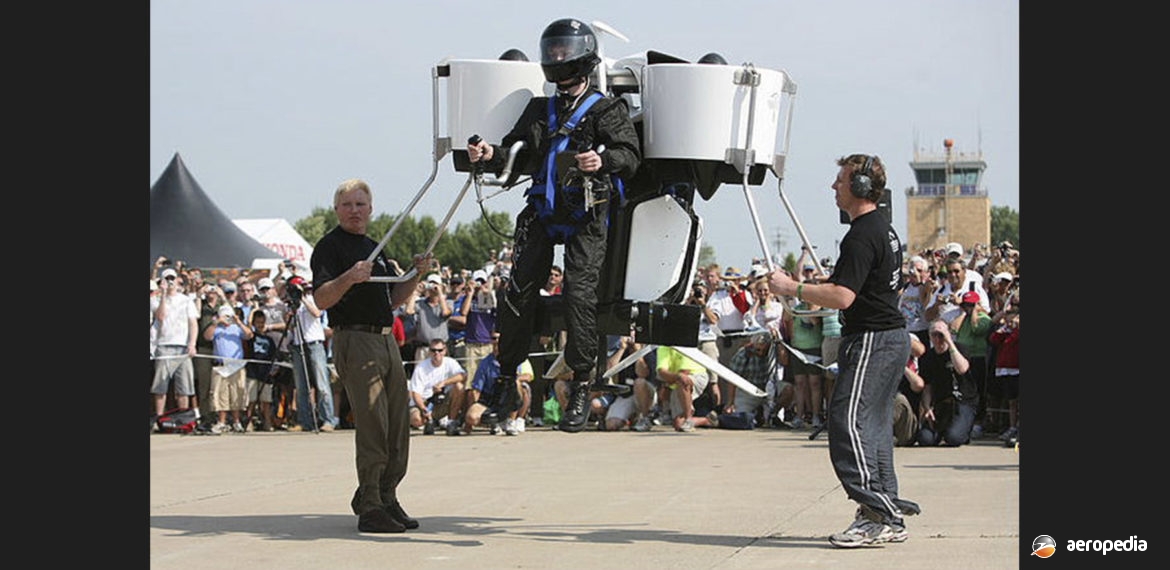Photograph:
Martin Aircraft Jetpack during a demonstration at the EAA event at Oshkosh, Wisconsin USA in 2008 (Martin Aircraft)
Country of origin:
New Zealand
Description:
Single-seat light sport aircraft
Power Plant:
One 149 kw (200 hp) Martin Aircraft 2-litre four-cylinder VEE two-stroke engine
Specifications:
- Wingspan: 1.70 m (5 ft 6 in)
- Length: 1.52 m (5 ft)
- Height: 1.52 m (5 ft)
- Cruising speed: 100 km/h (63 mph)
- Fuel capacity: 18.9 litres (4.15 Imp gals)
- Fuel burn: 38 litres/hr (8.35 Imp gals per hr)
- Flight time: 30 mins
- Range: 50 km (30 miles)
- Hover in ground effect and out of ground effect [estimated]: 2,438 m (8,000 ft)
- Weight excluding safety equipment: 115 kg (254 lb)
- Pilot weight – useful load –up to: 127 kg (280 lb)
History:
The Martin Aircraft Company Ltd is based in Christchurch, NZ, and was formed in 2004 with the assistance of investors, subsequently putting together a team of engineers to continue and complete the development of the Jetpack designed and built in the United States many years before by Glenn Martin. To this end discussions were held with commercial companies and civil defence organisations as to the use of the final completed item, and subsequently to develop a model for lighter personal and recreational use. The Company was listed on the New Zealand Stock Exchange.
On 29 May 2011 the prototype of the Jetpack was flown from the Canterbury Plains, climbing at 244 m/min (800 ft/min) to an altitude of 1,524 m (5,000 ft) at which time the ballistic Jetpack parachute was deployed to bring the machine safely back to terra firma. This flight was made as a remotely-controlled unmanned test flight. The machine is described as the world’s first practical Jetpack and consists of a purpose-built petrol engine driving twin ducted fans which produce sufficient thrust to lift the aircraft and a pilot in vertical take-off and landing modes, and which enables the machine to maintain sustained flight. The engine was designed to aviation industry standards. Although described as a “JetPack” it uses ducted fans, the jets being air from the ducted fans. The ducted fan blades are carbon/Kevlar composite, the diameter being 0.51 m (1.7 ft). It was unveiled at the EAA AirVenture event at Oshkosh in Wisconsin in July 2008 where it was classified as an experimental ultralight.
The manufacturer describes the machine as creating a new segment in the aviation and recreational vehicle markets, being initially designed for the leisure market. However, commercial demand has meant the program focused on readying the machine for use in a number of sectors, including emergency response, defence and recreation, with numerous applications in each sector. The Company also proposed an unmanned variant which will lift more than most vertical take-off and landing unmanned aerial vehicles. The machine is able to be deployed and operate from small areas. The pilot straps the machine on but it is too large for the pilot to walk with the machine attached.
The initial series was known as the P-11 and the prototype ZK-JME² (c/n P11-1) was first registered on 20 April 2011. After development and testing it was withdrawn from service on 5 November 2012. In August 2013 the P-12 was approved for testing, being registered as a Class 1 Microlight, although it did not completely meet regulations as it does not have a stalling speed. The P-12 had an empty weight of 200 kg (441 lb) and a loaded weight of 320 kg (705 kg).
Assembly of the P-12 prototype commenced on 18 July 2012, making a manned flight on 7 November 2012. The prototype became ZK-JME³ (c/n P12-1) to Martin Aircraft Co of Christchurch on 27 November 2012. The Jetpack is described as a Pilot License Unique Aircraft and owners are required to pass the Martin Aircraft Co approved training program before receipt of their aircraft. Production of the machine commenced and on 11 July 2014 two further examples were registered to the manufacturer, becoming ZK-JMJ² (c/n P12-2) and ZL-JMK² (c/n P12-3). These were followed by ZK-JML³ (c/n P12-4) and ZK-UTV (c/n P12-UTV), all these machines being registered in the Microlight Class 1 category but later ZK-JMK² was re-classified as a helicopter.
In November 2014 the majority (52 percent) of Martin Aircraft Co shares were purchased by Kuanechi Science, a research and development company in space technology based in Shenzen, China. The Company was also floated on the Australian Stock Exchange in February 2015 and was heavily over-subscribed on the private pre-initial public offering. At that time the company announced it had 40 potential pre-orders for its Jetpacks. In June 2015 Glenn Martin, the founder of the Company, left.
Development has continued and at Warbirds over Wanaka in March 2016 a variant was displayed, this being an unmanned model which became ZK-JMK² (c/n P12-3), this as noted above being redesignated as a helicopter. On 23 March 2015 the registration of ZK-JMJ² was cancelled. An unmanned Martin P-14 Jetpack was registered as ZK-MJA and three Series I aircraft became ZK-MJC (cn S.1-1), ZK-MJE and ZK-MJG. In late 2017 ZK-JPK (c/n S.1-4) and ZK-KCS (c/n S.1-5) were removed from the NZ Register as sold, having been exported. In September ZK-MJC was withdrawn from service.

